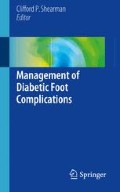Abstract
Once the integrity of the skin is disrupted, healing the resulting ulcer is a major therapeutic challenge. Peripheral neuropathy and ischaemia are well-recognised complications that lead to foot ulceration in a diabetic subject. In recent years, there has been growing evidence of high-prevalence neuroischaemia in the feet of diabetic patients.
Objective assessments of skin sensation, the macrocirculation and microcirculation permit routine wound healing. Given the incidence of neuroischaemia in this patient population, these assessments offer the possibility of preventive management and prediction of wound healing potential.
Access this chapter
Tax calculation will be finalised at checkout
Purchases are for personal use only
References
Abbott CA, Vileikyte L, Williamson S, Carrington AL, Boulton AJ. Multicenter study of the incidence of and predictive risk factors for diabetic neuropathic foot ulceration. Diabetes Care. 1998;21(7):1071–5.
van Schie CH. A review of the biomechanics of the diabetic foot. Int J Low Extrem Wounds. 2005;4(3):160–70.
Poitier L, Abi Khalil C, Mohamedi K, Roussel R. Use and utility of ankle brachial index in patients with diabetes. Eur J Vasc Endovasc Surg. 2011;41(1):110–6.
Aragon-Sanchez J, Lazaro-Martinez JL. Factors associated with calcification in the pedal arteries in patients with diabetes and neuropathy admitted for foot disease and its clinical significance. Int J Low Extrem Wounds. 2013;12(4):252–5.
Norgren L, Hiatt WR, Dormandy JA, Nehler MR, Harris KA, Fowkes FG, et al. Inter-society consensus for the management of peripheral arterial disease (TASC II). Eur J Vasc Endovasc Surg. 2007;33 Suppl 1:S1–75.
Smith FCT, Shearman CP, Simms MH, Gwynn BR. Falsely elevated ankle pressures in severe leg ischaemia: the pole test an alternative approach. Eur J Vasc Surg. 1994;8:408–12.
Sheehan P, Jones P, Caselli A, Giurini JM, Veves A. Percent change in wound area of diabetic foot ulcers over a 4-week period is a robust predictor of complete healing in a 12-week prospective trial. Diabetes Care. 2003;26(6):1879–82.
Prompers L, Schaper N, Apelqvist J, Edmonds M, Jude E, Mauricio D, et al. Prediction of outcome in individuals with diabetic foot ulcers: focus on the differences between individuals with and without peripheral arterial disease. The EURODIALE study. Diabetologia. 2008;51(5):747–55.
Apelqvist JAP, Leplantalo MJA. The ulcerated leg: when to revascularize. Diabetes Metab Res Rev. 2012;28 Suppl 1:30–5.
Armstrong DG, Lavery LA, Harkless LB. Validation of a diabetic wound classification system. The contribution of depth, infection, and ischemia to risk of amputation. Diabetes Care. 1998;21(5):855–9.
Mckinnell T, Sarah PA. Measurements in burns. In: Mani R, Romanell M, Shukla VK, editors. Measurements in wound healing: science and practice. New York: Springer; 2012.
Gurtner GC, Jones GE, Nelligan PC, Newman MI, Phillips BT, Sacks JM, Zenn MR. Intraoperative laser angiography using the SPY system; review of the literature and recommendations for use. Ann Surg Innov Res. 2013;7:1. Published online Jan 7, 2013. doi: 10.1186/1750-1164-7-1.
Author information
Authors and Affiliations
Corresponding author
Editor information
Editors and Affiliations
Rights and permissions
Copyright information
© 2015 Springer-Verlag London
About this chapter
Cite this chapter
Aragón-Sánchez, J., Mani, R. (2015). Predicting Wound Healing in the Diabetic Foot: Measuring Skin Viability. In: Shearman, C. (eds) Management of Diabetic Foot Complications. Springer, London. https://doi.org/10.1007/978-1-4471-4525-7_5
Download citation
DOI: https://doi.org/10.1007/978-1-4471-4525-7_5
Published:
Publisher Name: Springer, London
Print ISBN: 978-1-4471-4524-0
Online ISBN: 978-1-4471-4525-7
eBook Packages: MedicineMedicine (R0)

